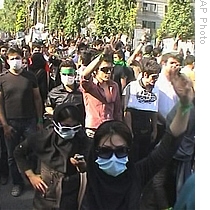17 June 2009
Thousands of non-professonal journalists in Iran have become the eyes and ears for the Western media looking for information about the on-going protests against last week's presidential election.
These "citizen" journalists are using the popular social-networking sites Twitter and Facebook.
The government has told foreign journalists not to venture into the streets to report on the daily marches but that has not stopped a growing number of "citizen" reporters from providing accounts of what is
 |
| Demonstrators in Tehran are shown in this scene taken from an amateur video. |
"We have been getting a constant stream of comments from inside Iran and it has been helpful in giving us a picture of what's happening," said Kevin Enochs, coordinating producer for the Persian News Network, a division of the Voice of America.
"What we're getting are comments from people participating in the protest marches," said Enochs.
Since much of the information is second-hand or could be biased, he admitted he must view the reports with a sense of skepticism. "We vet (scrutinize) the information as we would when we look at material from anyone's work, particularly the video taken by cell-phones," said Enochs.
"Some of the information comes from ex-patriots with family still in Iran," said Enochs, who has a brother living in Tehran.
The Persian News Network also uses Twitter and Facebook to communicate with people inside Iran by sending newscasts in very short bursts. "Twitter and Facebook have been valuable to us and we hope what we've sent to the people in Iran on these social networking sites has been valuable to them," said Enochs.